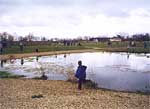Pre-historic KingstonIn prehistoric times this area was dense forest. It must have been inhabited for thousands of years as many finds have been made throughout the parish. Mesolithic flints were found in the area of the present bypass, Neolithic flints have been found in the north and south and a hand axe was found near the Hind's Head. As well as field marks, showing probable burial sites and farms, other finds include a Bronze Age knife and Iron Age pottery, these have been unearthed both at Kingstonhill Farm to the north and Thompson's Farm to the South The Romans in KingstonThe Romans left their mark. There are five probable sites of Romano-British occupation in the parish. There was a large Romano-British villa or farmstead near the crest of Kingston Hill which was occupied from the mid-first to the fourth century AD. During construction of a runway, for the Second World War airfield to the east of the village, a whole vase containing over 2000 coins from the reign of Maximian (307 AD) was dug up from an earthwork known as Aelfrith's Dyke. This is thought to be a Romano-British defence constructed in the 5th century AD against the invading West Saxons. It was mentioned in tenth century Saxon charters as a broad earth ditch and dyke (bank) which, at that time, indicated the parish boundary between Kingston Bagpuize and Fyfield. Today sections are still visible from the air. Saxon KingstonIn the land charter for Kingston, in 970, King Edgar granted 7 hides of land to Brihteah in the place called Cingestun (1 hide = about 100 acres). As now the parish was long and thin, being about 4 miles long and half a mile wide, stretching from the Thames in the north to the Ock in the south. The elongated parish gave a range of soil types, from the clay and alluvium in the north and south to a wide range of sandy loams in the higher Corallian ridge in the centre. 1066 and all thatAt the time of the Norman Conquest, in 1066, Cingestun (later called Chingestune and then Kingestun) was divided into 2 estates with Saxon lords of the manor. Thurchil had the northern part with the fishery and Stanchil had the southern half. Thurchil was killed at the Battle of Hastings, fighting for King Harold, and William seized both manors giving them to two of his military leaders. Thurkil's land was given to William Ansculfson who granted it to Adelelm and Henry de Ferrers received the other, granting it to Ralph de Bachepuise. He was one of Baron de Ferrers' officers and probably came from the Norman village now called Bacquepuis near Evreux.
Next: Kingston Church >> |



